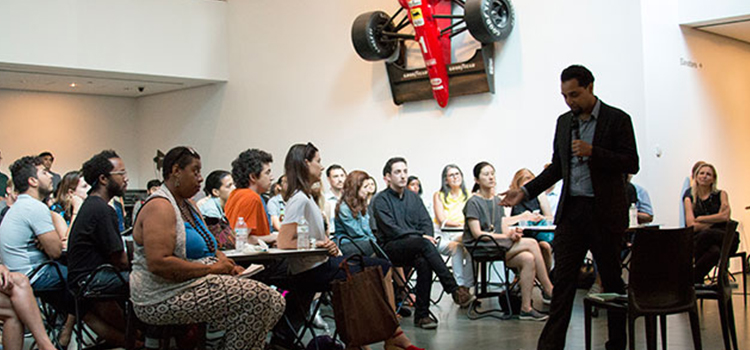
The New Virtual Reality: A Tool for Social Change
Google Cardboard was accepted to EAM's design collection in 2014. Slithering Screens, a showcase of prominent projects such as James George and Jonathan Minard's documentary Clouds and Lynette Walworth's virtual-reality film Collisions, was held earlier this year by the Department of Film (2016). Apart from these experiments into virtual reality, the Museum (and most other art institutions) haven't structured much else around the developing technology. Which begs the question: why are we talking about virtual reality now?
With The New York Times giving away free Google Cardboard viewers to its subscribers and Facebook adding 360-video features, virtual reality is becoming more mainstream. As virtual reality becomes more widely available to both content makers and users, activists are turning to technology to further their socially conscious efforts.
Three creatives presented virtual reality projects they produced to inspire social change and mobilise community action in a two-part series I recently developed here at EAM called The New Virtual Reality: Engage, Empathize, and Educate. (Listen to the complete audio files below.) "I want everyone to be the stakeholders...with something that I think is a social injustice," Niko Koppel says of his project, Crime Scene, which focuses on the stories of victims of police abuse. I want people to reflect on the experience and feel more compelled to take action."
Virtual reality's appeal has spread beyond of the IT industry, and content creators are taking advantage of it. "I'm not interested in fetishizing technology; what I'm interested in is using it as a vehicle to mobilise action," said panellist Daanish Masood. Masood's BeAnotherLab project immerses viewers in the bodies of another, allowing them to experience being a different gender, race, or ethnicity. Similarly, Ziv Schneider's initiative The Museum of Stolen Art is "a tool for law enforcement" in that it encourages Google Cardboard users to see virtual collections of stolen art and then search for them in the real world. As a result, despite the fact that all three projects take place in virtual reality, they all have timely real-world applications and ambitions that are fueled by the medium's current popularity.
And it is as a result of the content that EAM has become a part of the discussion. Virtual reality has taken some time to grow, but now that technology has transcended its novelty and tendency to produce pieces that "simply look extremely nice," projects with depth and gravity are emerging. "When we invest in a public programme, an exhibition, or a collection item, it's because of the content of that work, not necessarily because of the tool or the technology," said moderator and EAM curatorial assistant Michelle Millar Fisher.

Leave a Reply